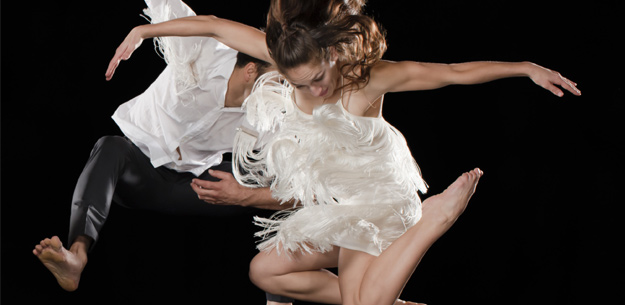The Executive Director at the Modlin Center for the Arts, Deborah Sommers, expounds upon the New Zealand-based dance company, Black Grace, and its visionary founder, Neil Ieremia. The company is coming to the Modlin Center March 7-8. Tickets are available here.
_____________________________________________________________________________________________
I first saw Black Grace Dance Company in 2004, then an all-male dance troupe, and was quite moved by the company’s work – a fusion of dance and cultural styles with electrifying rhythms. The dancers were of exceptional athletic ability. Today, Black Grace is not only known as New Zealand’s leading contemporary dance company, but as an internationally acclaimed group still performing powerful and expressive work that continues to inspire.
Since its inception in 1995, Black Grace has been in motion. Neil Ieremia, the Artistic Director and founder of Black Grace, was raised by Samoan parents in New Zealand.
Growing up within this context, he became interested in dance as a way to express the stories, emotions, and concerns of the contemporary Pacific Islander. To that end, the term ‘black’ in Black Grace refers to the courage in the New Zealand Māori-Pacific Islander argot of the 1980s.
Since 2005, Ieremia’s vision has extended beyond the original incarnation of the company. He describes the company’s evolution as transformative, and this has influenced both the span and vocabulary of his work, and the configuration of the dancers involved in each project. The dance troupe today consists of Pacific Islander, Samoan, and Maori male and female performers.
Through a blend of styles, Ieremia’s distinctive, rhythmically-charged, and pattern-oriented choreography addresses ideas about human nature, cultural disparities, and fosters dialogue about a world and country still separated by the cultural differences of its population. In his soul-searching exploration of identity, reflecting both his own inner search, and what it means to be the company called Black Grace, Ieremia introduces a new dance vocabulary by mixing Pacific Island traditional and contemporary dance styles.
Ieremia has also choreographed for the Royal New Zealand Ballet, the New Zealand Symphony Orchestra and Opera New Zealand. In 2003 he was nominated for the prestigious international Rolex Mentor Programme, and in 2005 received the Arts Foundation of New Zealand Laureate Award. He has created programs for inner city youth, and he is a 2009 recipient of the Paul D. Fleck Fellowship in the Arts from The Banff Centre, Canada.
The Modlin Center’s program includes the following work, which encompasses some of the following styles.
Pati Pati, which uses body percussion influenced by traditional Samoan Sasa (seated dance) and Fa’ataupati (slap dance).
Amata Act 3 – an excerpt from a full-length work entitled “Amata” that explores the theme of change. The piece uses compositional structure and floor patterns based on Samoan fine mats known as “ie toga.” The mat’s linear nature and weave pattern can also be found in the movement vocabulary, which is composed of various versions of a basic language phrase derived from letters, spoken conversations, arguments, and apologies.
The evening concludes with Vaka. This piece uses a raft as a metaphor for hope and is based on travelling and displacement. The experience of leaving home behind, saying goodbye to loved ones, and finding yourself in a new place and culture as so many immigrants have done across time is encapsulated in this piece. It was inspired by the controversial portrayal of Maori explorers in the infamous painting “The Arrival of the Maoris in New Zealand” by Louis J. Steele and Charles F. Goldie 1898.
As Ieremia explains, “The journey of every vaka (canoe) faces challenges and danger as it navigates towards an often unknown future. We are constantly asked to evolve and adapt in order to survive. How much of ourselves do we allow to change?” Ieremia has certainly addressed this question over many years. It is a relevant question –one that many people may consider both individually and as a society in general.
_____________________________________________________________________________________________
As Executive Director of the Modlin Center for the Arts, Deborah Sommers is responsible for the 45-event Great Performances Series, four main stage productions by the University's theatre and dance department and the University Players and Dancers, 30 musical performances in the Department of Music's Free Concert Series, plus community events and performances throughout the year. Sommers also directs and teaches Richmond's arts management program and works with faculty across the disciplines to design academic components that coordinate with the Modlin Center's artistic programming.
Prior to joining the Modlin Center, Sommers was director of programming at Fairfield University's Quick Center for the Arts. Since 1992 Sommers has produced an 80-event season of national and international artists that attracts patrons from across the New York area. She also lead a K–12 outreach program touching 14,000 students with long- and short-term artist residencies in public schools, supervised an internship program for university students, and oversaw a children's theatre summer camp and adult summer festival chorus.
Before joining the Quick Center, Sommers was company administrator of the Performing Arts Center at the State University of New York at Purchase, coordinating the professional season programming, artists, and residencies. She also worked for the PepsiCo Summerfare Festival. A graduate of Hunter College with a bachelor's degree in music and education, Sommers subsequently earned both an M.B.A. and doctor of jurisprudence from Pace University. She is admitted to the New York and Connecticut bars and has sat on several boards and committees, including the United Nations Development Fund for Women USA-Connecticut Chapter, Fairfield Arts Council, and Connecticut Dance Alliance.


No comments:
Post a Comment